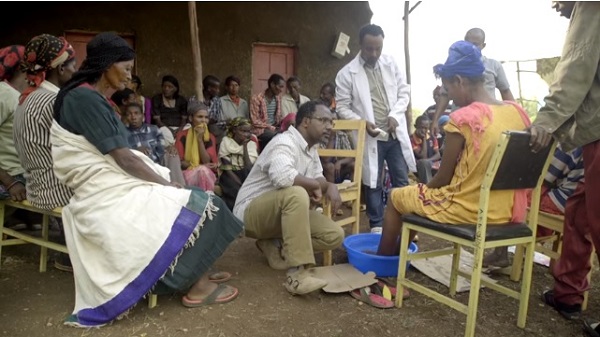
Podoconiosis is a geochemical disease occurring in individuals exposed to red clay soil of volcanic origin. This Neglected Tropical Disease (NTD) is highly prevalent in Ethiopia. According to the nationwide mapping in 2013, podoconiosis disease is endemic in 345 districts, where an estimated 35 million people live.*
Podoconiosis disease: endemic non-filarial elephantiasis
Podoconiosis is a type of tropical lymphoedema clinically distinguished from lymphatic filariasis (LF) through being ascending and commonly bilateral but asymmetric. Evidence suggests that podoconiosis is the result of a genetically determined abnormal inflammatory reaction to mineral particles in irritant red clay soils derived from volcanic deposits.
Distribution
Podoconiosis is found in highland areas of tropical Africa, Central America and north-west India.
Disease burden
Population-based surveys suggest a prevalence of 5–10% in barefoot populations living on irritant soil. In Ethiopia, 1 million people are estimated to be affected, while in Cameroon, a further 500 000 people are estimated to be affected. The economic consequences are severe: productivity losses per patient amount to 45% of working days per year, thus economic losses to a country such as Ethiopia exceed US$ 200 million per year. Stigmatization of people with podoconiosis is pronounced; patients being excluded from school, local meetings, churches and mosques, and barred from marriage with unaffected individuals.
Who is affected?
Men and women are equally affected in most communities. All of the major community-based studies have shown onset of symptoms in the first or second decade and a progressive increase in podoconiosis prevalence up to the sixth decade. Farmers who for cultural reasons or through sheer poverty do not wear shoes are at high risk, but the risk extends to any occupation with prolonged contact with the soil.
Pathology
Podoconiosis disease is characterized by a prodromal phase before elephantiasis sets in. Early symptoms commonly include itching of the skin of the forefoot and a burning sensation in the foot and lower leg. Early changes that may be observed are splaying of the forefoot, plantar oedema with lymph ooze, increased skin markings, hyperkeratosis with the formation of moss-like papillomata (left) and rigid toes. Later, the swelling may be one of two types: soft and fluid, or hard and fibrotic, often associated with multiple hard skin nodules. Acute adenolymphangitis episodes occur in which the patient becomes pyrexial and the limb warm and painful. These episodes appear to be related to progression to the hard, fibrotic leg.
Diagnosis
Diagnosis is based on location, history, clinical findings and absence of microfilaria or antigen on immunological card test. Podoconiosis occurs in populations living at high altitudes (more than 1000 meters above sea level).
Disease starts in the foot and progresses up the leg to the knee but rarely involves the groin; conversely, LF is found at lower altitudes and changes often are noticed first in the groin.
Prevention and management
Primary prevention of podoconiosis disease consists of avoiding or minimizing exposure to irritant soils by wearing shoes or boots and by covering floor surfaces inside traditional huts.
Secondary prevention involves training in a simple lymphoedema treatment regimen, similar to that used in management of LF lymphoedema. The regimen includes daily foot-washing with soap, water and antiseptic, use of a simple emollient, bandaging in selected patients, elevation of the leg, controlled exercises, and use of socks and shoes. Compression bandaging is highly effective in reducing the size of the soft type of swelling (patient shown before [left] and after [right] 6 months of treatment).
Tertiary prevention encompasses secondary prevention measures, elevation and compression of the affected leg, and, in selected cases, removal of prominent nodules. More radical surgery is no longer recommended since patients unable to scrupulously avoid contact with soil experience recurrent swelling which is more painful than the original disease because of scarring. Social rehabilitation is vital, and includes training treated patients in skills that enable them to generate income without contact with irritant soil.
* Deribe K, Kebede B, Mengistu B, et al. Podoconiosis in Ethiopia: From Neglect to Priority Public Health Problem. Ethiopian Medical Journal. 2017;55(Suppl 1):65-74.
Source: WHO
